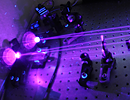Resonator delivers short light pulses for multi-photon entanglement
01.02.2010
An important milestone towards the construction of a quantum computer is the generation and investigation of large quantum systems. To this end, photons – the particles of light – are promising candidates. Physicists of the group of Prof. Harald Weinfurter (at the Ludwig-Maximilians-Universität München and the Max-Planck-Institute of Quantum Optics, Garching, Germany, in the Cluster of Excellence “Munich Center for Advanced Photonics”) succeeded in developing a new method for the generation of intense, ultra-short light pulses in the ultraviolet (UV) wavelength region at high repetition rates. These pulses are essential for the generation of multiple entangled photons. The physicists also envisage applications in other fields of physics like optical spectroscopy.
The goal of the Munich scientists is to entangle as many photons as possible and to study their properties. Entanglement, or Einstein’s “spooky action at a distance”, still fascinates quantum physicists today. Therefore, their focus is not only on realizing the quantum computer, but they would also like to obtain a deeper insight into the world of quantum physics and to understand how entanglement is distributed over large quantum systems. To generate several entangled photons at once, ultra-short stroboscope-like light pulses of very high power are required. The main challenge for this project was to obtain ultra-short, high energy pulses with a high repetition rate and at UV wavelengths. All these demands had to be fulfilled at the same time.
The Munich team has now succeeded in transferring a method working in the infrared wavelength region to the more powerful ultraviolet region. They implemented a resonator to enhance UV light pulses with a pulse duration in the femtosecond regime (10-15 seconds) at a high repetition rate (82 MHz). Inside the resonator the pulses continuously add up only if the following condition is fulfilled: each incoming pulse has to overlap exactly with the pulses already stored in the resonator. The light intensity created in the resonator exceeds those of comparable commercial laser systems by at least a factor of five. A crystal inside the resonator then allows the generation of entangled photons.
Roland Krischek, who co-constructed and characterized the light resonator, sees a lot of potential: “This light resonator allows us to study entanglement of larger quantum systems.” His colleague Witlef Wieczorek remarks: “This resonator can not only be used to generate multi-photon entanglement but also to analyze, for example, molecular formation or carrier dynamics in semiconductors.” (MAP/suwe)


